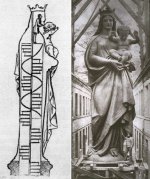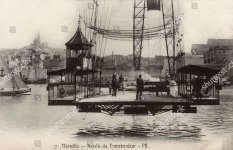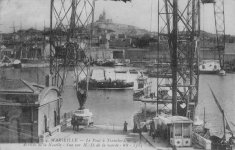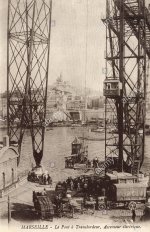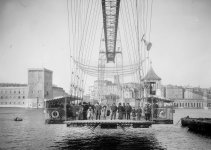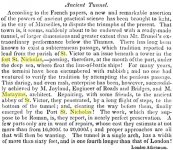Found the below article saved up in one of my SH-1 days folders. Nothing came out of it back then. The piece is talking about some ancient tunnel that was allegedly "cleared" shortly prior to 1845. Here is my take on the below article:
As you can see, we have approximately 950 feet from center to center. It would be interesting to figure out where additional 700 feet could be hiding at.
We have the following older plans of the port of Marseille:
I'm not sure I can figure out even the direction of this tunnel. If we use the description provided in the article, there is only one direction we can have.

At the same time we are being told that the tunnel went from Fort Saint Nicholas to the parish of Saint Victor. If this parish of Saint Victor is the same as the Abbey of Saint-Victor, I'm not sure it makes sense.
At the same time, when we look at the below 1575 map, Fort Nicholas and the Chapel of Saint Victor (K) are on the opposite sides of the port.

(F) also has something to do with Saint Victor. I marked it just in case. It's on the opposite side of the port (from Fort Saint Nicholas) as well.

Considering that the above-mentioned 1845 article was produced when the St. Victor place was on the same side with Fort Nicholas, it still does not make sense, but here is where it gets interesting.
I don't think that Bassin de Carénage was considered to be the Old Port back in the day. It does not look like a "deep sea" to me. Than again, who knows?
In the process of working on this article (just now), I've run into the following rebuttal. Now I'm twice as suspicious of this entire Old Port of Marseille tunnel saga.
Note: In the above rebuttal they are talking about a tunnel connecting Fort Saint Jean and Fort Saint Nicholas.
Note: In the above rebuttal they are talking about a tunnel connecting Fort Saint Jean and Fort Saint Nicholas.
KD: If you know what tunnel they discovered around 1845, please share some links.
- 1. There were rumors about the existence of the tunnel. They kind of knew that it existed, but it's written like they did not know where it was.
- 2. They did not really know who built it, but assumed that ancient Romans did.
- 3. The tunnel was in "nearly perfect preservation".
- 4. It was a 60 foot wide single arch tunnel.
- 5. It was 25% longer than the Thames Tunnel allegedly built by Brunel between 1825 and 1843.
- 1,300 feet (396 meters) + 25% = 1,625 feet (495 meters)
- 6. The tunnel was between one of the towers of Fort Saint Nicholas(star fort) and the parish of Saint Victor.
- 7. The tunnel was built at the "mouth of the port" and went under the "deep sea".
As you can see, we have approximately 950 feet from center to center. It would be interesting to figure out where additional 700 feet could be hiding at.
We have the following older plans of the port of Marseille:
I'm not sure I can figure out even the direction of this tunnel. If we use the description provided in the article, there is only one direction we can have.
- The tunnel was built at the "mouth of the port" and went under the "deep sea".
At the same time we are being told that the tunnel went from Fort Saint Nicholas to the parish of Saint Victor. If this parish of Saint Victor is the same as the Abbey of Saint-Victor, I'm not sure it makes sense.
- There clearly is no "deep sea" there.
- The distance is not adequate.
- I marked (blue) an approximate length of our phantom 60 foot wide 1,625 foot long "antient" tunnel going in the direction that would make sense.
At the same time, when we look at the below 1575 map, Fort Nicholas and the Chapel of Saint Victor (K) are on the opposite sides of the port.
(F) also has something to do with Saint Victor. I marked it just in case. It's on the opposite side of the port (from Fort Saint Nicholas) as well.
Considering that the above-mentioned 1845 article was produced when the St. Victor place was on the same side with Fort Nicholas, it still does not make sense, but here is where it gets interesting.
The Vieux-Port Tunnel
The Saint-Laurent tunnel or tunnel of the Old Port of Marseille (The Vieux-Port Tunnel) is located in downtown Marseille near the entrance to the city's former commercial port, now a marina.- It connects the north and south shores of the port and in fact the north and south districts of the city.
- It is in fact made up of two tunnels - East and West - with two lanes each and reserved for light vehicles.
- Its length is 600 meters (1,968 feet).
- In the 1960s, Marseille was already experiencing endless traffic jams.
- The municipality then imagines the construction of a tunnel under the old port to relieve traffic congestion.
- Work began in 1964 . The tunnel is inaugurated on December 17 , 1967.
- The construction of the tunnel was spread over 35 months, between 1964 and its inauguration on December 16, 1967.
- The work was directed by Georges Lacroix, director general of the technical services of the City and engineer of the bridges and roads. From the start, the latter alerted the municipality that the site would be of a "scale hitherto unknown in an urban site" , as shown in the brochure of the time published here.
- The tunnel is in fact made up of two juxtaposed tubes separated by an interval of one meter, the best way to meet the technical constraints of the site.
- And to interfere as little as possible with navigation in the Old Port during the work, Georges Lacroix decided to prefabricate the underwater structures in the fairing basin. "The company's facilities have to be content with cramped spaces, which leads to adopting an original solution and using as a work and prefabrication area the bottom of the fairing basin previously dried and fitted out", we can read.
I don't think that Bassin de Carénage was considered to be the Old Port back in the day. It does not look like a "deep sea" to me. Than again, who knows?
In the process of working on this article (just now), I've run into the following rebuttal. Now I'm twice as suspicious of this entire Old Port of Marseille tunnel saga.
Note: In the above rebuttal they are talking about a tunnel connecting Fort Saint Jean and Fort Saint Nicholas.
Note: In the above rebuttal they are talking about a tunnel connecting Fort Saint Jean and Fort Saint Nicholas.
KD: If you know what tunnel they discovered around 1845, please share some links.
- Did we build the Vieux Port Tunnel, or the "ancient Romans" did?
- If you find some decent Vieux Port Tunnel construction photographs, please share those as well.


